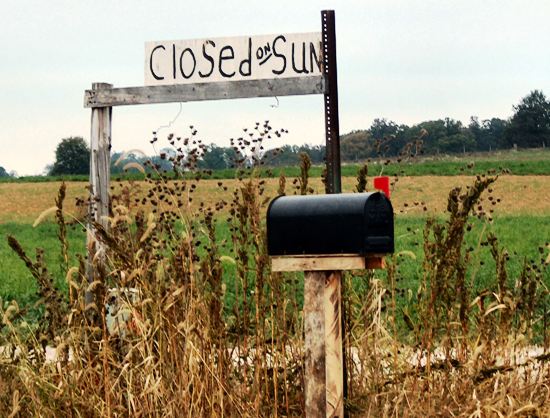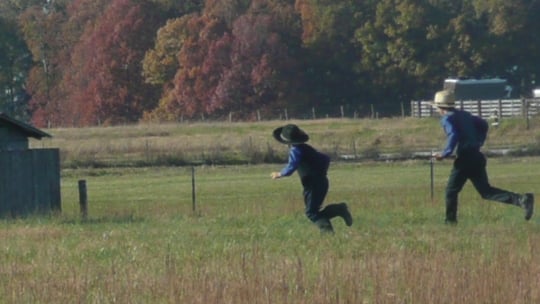Amish “Supercounties”
I mentioned this idea of Amish “supercounties” in a recent post. This is the term I came up with to describe counties containing a large number of individual Amish communities. For one reason or another, these are counties which have just drawn Amish to settle in them, repeatedly. An alternate term might be “Amish-friendly counties”.

There is something about these counties that makes them attractive to Amish, and it can often mean Amish from a diversity of groups (some more plain, some more progressive). An important note is that these are not the counties with the highest Amish populations. Those tend to be the counties dominated by one large settlement, like Holmes or Geauga in Ohio, or Lancaster in Pennsylvania.
Rather these are the ones that have generated the most separate and distinct individual settlements. In fact, many of these supercounties have low total Amish populations – for instance, Osceola County in Michigan has six separate settlements, but each is just one church district in size.
So these are significant not for their total Amish population, but for their enduring attractiveness as a location for Amish life. To continue with the example of Osceola County, the oldest settlement there was founded in 1989, and Amish were still finding reasons to settle the area (and the room to do so) nearly a quarter-century later, with communities established in 2012 and 2013.

Each settlement represents a decision by one or an initial handful of Amish families to uproot and move to that area and call it home. These counties have proven attractive enough – be it for reasons like land price, proximity to other Amish communities, scenery, or other factors, to cause groups of Amish families to take that decision on multiple occasions, and for the most part, successfully.
If they chose well and things fall into place, they will be followed by more families and the settlement will grow. Alternatively, the settlement may remain the same size or grow only slowly for years, or may eventually disappear.
But it should be noted that Amish don’t necessarily start new communities with the goal of having a large community in the new location one day. On the contrary, they are often moving to more remote locations specifically to get away from “busy” large settlements.

A final note – the existence of an Amish settlement in a given place can act as a filter for other Amish in considering the area. If Amish have lived in a general area for some time in peace and prosperity, that is a sign to others that there is something attractive about the location. It can signal that English neighbors are helpful and accommodating, roads manageable, and questions of land and making a living have been explored and resolved.
Amish Supercounties
I am defining an Amish supercounty as a county with at least five settlements (or partial settlements, shared with another county or counties). I originally considered six as the cut-off, but five offers a bit wider scope, and under that broader definition we have 10 counties in 7 states on the list.
The 10 Amish Supercounties
Maine
1. Aroostook County (5 settlements)
Michigan
2. Osceola County (6)
Minnesota
3. Todd County (5)
New York
4. St. Lawrence County (6)
Ohio
5. Ashtabula County (6)
6. Knox County (5)
Pennsylvania
7. Crawford County (7)
8. Mercer County (6)
Wisconsin
9. Grant County (5)
10. Vernon County (5)
If you also consider the counties with three or four distinct settlements (also suggesting a place is good for Amish living), the list could be much larger (by several dozen). Maybe that expanded definition is better, but for now I am sticking with five. I’ve based the above on the 2020 County & State Amish Population List.







three contiguous
Three of the counties on your list are next to each other, that is, contiguous. They are Ashtabula, OH., plus Mercer and Crawford Counties, PA — a total of 19 settlements in a try-county area.
Thanks for pointing that out. I keep forgetting that Ashtabula is right next to those two. I should also add this here for anyone interested in looking further at Amish population info at the county level: “The Amish Population: County Estimates and Settlement Patterns”. Lot of interesting info.
https://media.npr.org/documents/2014/june/ohiostatecensus.pdf
questions
do Amish where a mask?
under he present conditions with this virous . would it be a good time to visit ?
what city’s in Ohio county’s are Amish near?
if possible I would like to talk to you.
another question
do Amish get the vaccine shots for the virus ?
Allen county,In
A very large Amish community exists in Allen county,Indiana. You should seriously look at this community. In the Ft Wayne area, stretching into dekalb county, i.e. Auburn , Indiana. Here, my amish friends do alot of construction. New homes, remodles, cabinitry, concrete, pole barns , (if it is’nt red, its a company shed), lumber yards, pallet building, needless to say its vast. I work for a cabinet shop/ new home construction/remodel business.
Imperial Homes.. Lee Schmucker Sr, Amish Doors & Decor… Leroy Schmucker jr & His Brother, Lynn A Schmucker. Ive been with these guys, i call family, for 2 yrs now. Long story. Needless to say, they did my kitchen and master bath, called me a week later, and ive been with them ever since. I love them as my own brothers. Thier families are my family, as mine is thiers. Please pay us a visit and feel welcome to sit and have some insightful conversation and some grub off the big green egg!
Thank you for your time!
Grabil/New Haven
Gary’s comment was nostalgic for me because the first time I walked into an Amish home was in that community. I was a “young pup” professor in the Dept. of Agricultural Economics at Purdue University and was brought onto to a project about soil erosion in the Black Creek watershed. They needed a social scientist for the Amish part of it. Unfortunately, soon after the visit to the area, I moved to The Ohio State University. There are a number of Amish communities in counties on the border with Ohio, from Hamilton (Steuben County) to Graill/New Haven (Allen County), Berne/Monroe/Geneva (Jay and Adams Counties), Hagerstown/Greensfork (Henry, Randolph and Wayne Counties — Wayne is the one that border Ohio), and two Vevays (Switzerland County — one is Swiss and the other is Old Order).
Nice to hear that community mentioned here by Gary and to learn that story about you Joe. I wonder what your first impressions were. My first experience in Allen County came after about 8 weeks in Elkhart/LaGrange (selling books). In comparison I found it significantly harder to establish rapport with the Amish people I met there, at least for the first day or two until I started making more connections. There was more of a shell to crack but I do remember some very warm and kind souls there in the couple weeks I spent. So it’s nice to hear from you Gary here about your friendships there.
Seeking info if you know..
Hi, I have a question about Amish that has moved to our area, if by chance you know. It is Whitehall,(Washington County), New York..I believe they have been here for maybe 4/5 yrs..There are some all around Whitehall..Just curious if you have any info on them..I believe they bought up quite a bit of old farm land..I always take rides on the country roads, And I have to say they have beautified the country side out there..Love driving around that area now..I was just curious if you knew where they originated from?
Thanks, love your articles
Alberta
Whitehall, New York
According to my notes, Whitehall was founded in 2014 from Amish who lived in the central New York settlement of Fort Plain/Honda. In turn, the Fort Plain/Honda group was founded in 1986 and originated from the larger Amish settlement called New Wilmington, PA (western PA). The New Wilmington group (founded way back in 1847) is a bit more plain than Old Order and are known for buggies that are burnt orange in color and for a preference for wearing brown clothing. The NW group is large (21 church districts and about 2750 persons), whereas the Fort Plain/Honda group is about four church districts in size (about 650 persons), and Whitehall is one church district in size about 150 persons. Go to the Young Center for Anabaptist and Pietist Studies for more on population information.